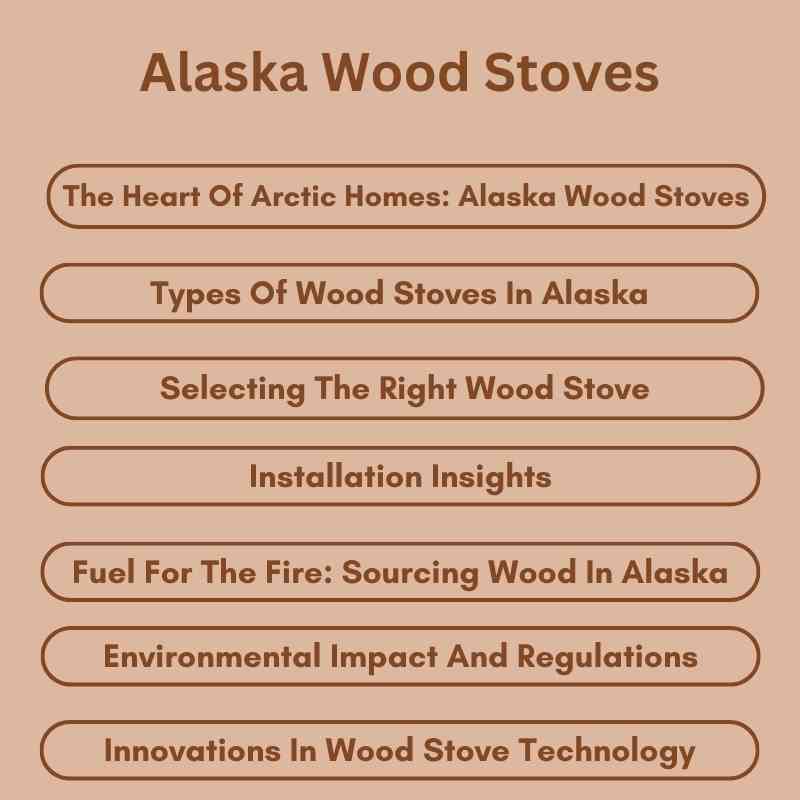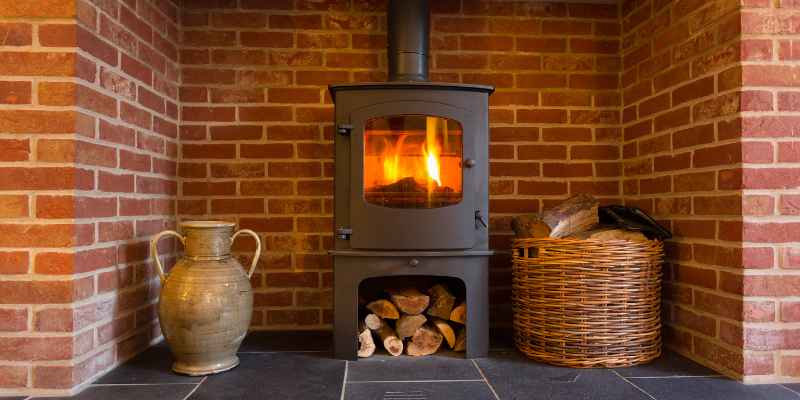Alaska Wood Stoves are efficient heating solutions designed for cold climates. They provide reliable warmth while being environmentally friendly.
Alaska Wood Stoves have gained popularity for their efficiency and durability. These stoves are specifically crafted to handle the harsh winters of Alaska and similar regions. Homeowners appreciate their ability to generate significant heat while minimizing fuel consumption. The stoves feature advanced technology that allows for better air control and reduced emissions, making them a greener choice.
With various styles and sizes available, homeowners can find a model that fits their unique needs. Whether you’re looking to heat a small cabin or a larger home, Alaska Wood Stoves offer practicality without compromising on aesthetics. Investing in one of these stoves ensures comfort and warmth during the coldest months.
The Heart Of Arctic Homes: Alaska Wood Stoves
Alaska wood stoves are essential for warmth and comfort. These stoves are more than just heating sources. They symbolize resilience and community in the Arctic. Each stove tells a story of survival against harsh winters.
Why They’re A Must-have
Alaska experiences long, cold winters. Wood stoves provide efficient heating for homes. They offer several key benefits:
- Cost-Effective: Wood is often cheaper than other fuels.
- Reliable: Stoves can operate during power outages.
- Eco-Friendly: Wood is a renewable resource.
- Cozy Ambiance: The glow of wood creates a warm atmosphere.
Cultural Significance
Wood stoves hold a special place in Alaskan culture. They are central to family gatherings. Sharing stories around a stove creates bonds.
Many indigenous communities rely on wood stoves. They represent traditions passed down through generations.
Here are some cultural aspects of Alaska wood stoves:
| Aspect | Significance |
|---|---|
| Heating | Essential for survival in extreme cold. |
| Cooking | Useful for preparing traditional meals. |
| Community | Gathering place for friends and family. |
| Tradition | Part of ancestral ways of living. |
Alaska wood stoves are more than just appliances. They are lifelines that keep homes warm and hearts connected.

Types Of Wood Stoves In Alaska
Alaska offers a variety of wood stoves. Each type serves different needs. Understanding these types helps in making the right choice.
Traditional Vs. Modern Designs
Wood stoves come in two main designs: traditional and modern.
| Feature | Traditional Designs | Modern Designs |
|---|---|---|
| Appearance | Classic, rustic look | Sleek, contemporary style |
| Efficiency | Lower efficiency | Higher efficiency |
| Heat Output | Good heat output | Excellent heat output |
| Price | Generally lower cost | Higher initial investment |
Traditional stoves offer a cozy feel. They are often made of cast iron or steel. Modern stoves focus on efficiency and design. They use advanced materials and technology.
Features And Innovations
Wood stoves in Alaska now include various features. Innovations improve safety and performance.
- EPA Certification: Many stoves meet strict emissions standards.
- Oven Options: Some models have built-in ovens for cooking.
- Adjustable Air Control: This feature allows better heat management.
- Blower Systems: These help circulate heat evenly.
Innovations make wood stoves more user-friendly. They offer better heat retention and less wood consumption. Homeowners can enjoy warmth without excessive fuel costs.
Selecting The Right Wood Stove
Selecting the right wood stove is crucial for warmth and comfort. A suitable stove can enhance efficiency and reduce emissions. Consider three main factors: size, efficiency, and material.
Size And Heating Capacity
Choosing the correct size ensures your space stays warm. Stoves come in various sizes. Here’s a quick guide:
| Room Size (sq ft) | Recommended Stove Size (BTUs) |
|---|---|
| 500 – 1,000 | 15,000 – 25,000 |
| 1,000 – 1,500 | 25,000 – 35,000 |
| 1,500 – 2,000 | 35,000 – 50,000 |
Match the stove’s heating capacity to your room size. A larger stove can overheat small spaces. A smaller stove will struggle in large areas.
Efficiency And Emissions
Efficiency measures how well a wood stove uses fuel. Higher efficiency means less wood used. Look for stoves with:
- 80% efficiency or higher
- EPA certification for lower emissions
Lower emissions are better for the environment. Efficient stoves save money on fuel costs.
Material And Durability
The material impacts the stove’s lifespan and performance. Common materials include:
- Cast Iron: Durable, retains heat well.
- Steel: Lightweight, heats up quickly.
- Soapstone: Excellent heat retention, expensive.
Consider how often you’ll use the stove. Choose a material that suits your needs.
Installation Insights
Installing an Alaska wood stove requires careful planning and execution. Proper installation ensures efficiency and safety. Here are key insights to consider.
Professional Vs. DIY Installation
Choosing between professional installation and DIY can impact your experience. Here are some points to think about:
- Professional Installation:
- Ensures compliance with local codes.
- Reduces the risk of errors.
- Provides warranties on work done.
- DIY Installation:
- Can save money on labor costs.
- Gives a sense of accomplishment.
- Requires knowledge of local building codes.
Safety Standards
Safety is crucial in wood stove installation. Follow these safety standards:
| Standard | Description |
|---|---|
| Clearances | Maintain space around the stove to prevent fires. |
| Chimney | Use a certified chimney for proper venting. |
| Carbon Monoxide Detector | Install to alert you of dangerous gases. |
Maintenance Tips
Regular maintenance keeps your Alaska wood stove running efficiently. Follow these tips:
- Clean the chimney at least once a year.
- Check for creosote buildup regularly.
- Inspect seals and gaskets for wear.
- Keep the firebox clean and free of ash.
Following these maintenance tips can extend the life of your stove. Stay warm and safe this winter!
Fuel For The Fire: Sourcing Wood In Alaska
Sourcing wood in Alaska is vital for heating homes. The right type of wood ensures a steady, efficient burn. Alaskans prioritize local wood types, sustainable practices, and proper storage.
Local Wood Types
Alaska boasts diverse wood species ideal for heating. Here are some popular types:
| Wood Type | Burning Characteristics |
|---|---|
| Spruce | Burns fast, produces moderate heat. |
| Birch | High heat output, burns slowly. |
| Pine | Easy to ignite, produces more creosote. |
| Alder | Good for cooking, burns clean. |
Sustainable Practices
Choosing sustainable wood practices is essential. Here are a few tips:
- Harvest responsibly: Cut only what you need.
- Replant: Plant new trees after harvesting.
- Use dead or downed trees: They help reduce fire hazards.
Support local suppliers who prioritize eco-friendly methods. This ensures forests remain healthy for future generations.
Storage And Seasoning
Proper storage and seasoning enhance wood’s burning quality. Follow these steps:
- Store wood off the ground: Use pallets or racks.
- Cover wood: Protect it from rain and snow.
- Season wood: Let it dry for at least 6 months.
Well-seasoned wood burns hotter and cleaner. Monitor moisture levels for best results.
Environmental Impact And Regulations
Alaska wood stoves play a significant role in heating homes. They also have an impact on the environment. Understanding regulations and emissions is crucial. This ensures cleaner air and healthier ecosystems.
Emission Standards
Emission standards are essential for controlling air quality. These regulations limit the amount of smoke and pollutants released by wood stoves. Compliance helps reduce harmful emissions.
| Emission Type | Standard Limit (g/hr) |
|---|---|
| Particulate Matter | 2.5 |
| Carbon Monoxide | 4.0 |
Manufacturers must meet these standards for approval. Homeowners should check for certification labels. This ensures they use compliant wood stoves.
Impact On Local Ecosystems
Wood burning affects local air quality and wildlife. Smoke can harm trees, plants, and animals. It is vital to use wood stoves responsibly.
- Choose seasoned wood for burning.
- Avoid burning treated or painted wood.
- Keep the stove well-maintained for efficiency.
Educating communities about responsible wood stove usage is important. This can help preserve Alaska’s natural beauty. Together, we can protect local ecosystems while enjoying warmth and comfort.
Innovations In Wood Stove Technology
Wood stove technology has evolved remarkably in recent years. New innovations enhance efficiency and user experience. These advancements benefit both the environment and homeowners. Discover how modern wood stoves are changing the game.
Smart Stoves: The Future
Smart stoves are transforming how we heat our homes. They integrate technology for better control and monitoring. Here are some key features:
- Remote Control: Adjust settings from your smartphone.
- Wi-Fi Connectivity: Monitor performance from anywhere.
- Automated Scheduling: Set heating times for convenience.
- Real-Time Alerts: Receive notifications for maintenance needs.
Smart stoves offer convenience and efficiency. They allow users to optimize energy use. This leads to lower heating costs and a reduced carbon footprint.
Improvements In Efficiency
Modern wood stoves now focus on efficiency. New designs reduce emissions and increase heat output. Here are some improvements:
| Feature | Old Model | New Model |
|---|---|---|
| Burn Time | 4-6 hours | 10-12 hours |
| Efficiency Rating | 60-70% | 80-90% |
| Emissions | 4-5 grams/hour | 1-2 grams/hour |
New wood stoves use advanced combustion techniques. These stoves burn fuel more completely. Users enjoy more heat with less wood. This leads to significant savings.
Investing in modern wood stove technology makes sense. It offers better performance and a greener option for heating.
Living With A Wood Stove: Stories From Alaskan Homes
Wood stoves are more than just heating appliances in Alaska. They are the heart of many homes. Alaskans share stories of warmth, community, and survival. A wood stove offers comfort during long, cold winters. Let’s explore everyday life and the challenges of winter in Alaska.
Everyday Life
In Alaska, wood stoves become part of daily routines. Families gather around the stove, sharing stories and laughter. Cooking meals on the stove is common, adding flavor to family life. Here are some everyday activities:
- Heating water for baths
- Baking bread and treats
- Drying clothes
- Making hot drinks
Wood stoves also provide a sense of security. They keep homes warm during power outages. Many Alaskans learn to chop and stack wood. This skill becomes essential for winter survival.
Surviving The Depths Of Winter
Winter in Alaska can be harsh. Temperatures drop significantly, often below zero. Homes equipped with wood stoves become safe havens. Here’s how families survive:
| Challenge | Solution |
|---|---|
| Extreme Cold | Use wood stoves for consistent heat |
| Power Outages | Rely on wood stoves for cooking |
| Snow Accumulation | Clear chimney regularly |
| Wood Supply | Stockpile wood in summer |
Families share stories of gathering wood together. Children learn the importance of hard work. They understand the value of community support. Neighbors often help each other during tough times. This bond strengthens their connection to the land.
In the depths of winter, the warmth of a wood stove brings comfort. It creates a space for families to come together. These stoves are not just appliances; they are symbols of resilience.

Frequently Asked Questions
What Are The Benefits Of Alaska Wood Stoves?
Alaska wood stoves provide efficient heating for homes. They offer an eco-friendly alternative to fossil fuels. Many models are designed for high efficiency and low emissions. Additionally, they create a cozy ambiance while being cost-effective for heating.
How Do I Choose The Right Alaska Wood Stove?
Selecting the right wood stove involves considering size, efficiency, and style. Measure your space to ensure proper fit. Look for high-efficiency ratings for better performance. It’s also essential to choose a model that complements your home decor.
Are Alaska Wood Stoves Easy To Maintain?
Yes, Alaska wood stoves are generally easy to maintain. Regular cleaning of the stove and chimney prevents creosote buildup. Inspect the seals and gaskets periodically for wear. Many models have simple designs that make maintenance straightforward and efficient.
Can I Use Any Type Of Wood In Alaska Stoves?
Not all wood types are suitable for burning. Hardwoods like oak and maple burn hotter and longer. Softwoods like pine ignite quickly but produce more creosote. Always use seasoned wood for optimal performance and reduced emissions.
Conclusion
Choosing the right wood stove for your Alaska home is essential for warmth and comfort. Consider factors like efficiency, size, and style. Quality wood stoves not only enhance your living space but also provide reliable heating. Invest wisely to enjoy cozy winters and reduce energy costs.
Stay warm and informed!

